by Cathleen Newsham | Nov 15, 2018 | events
1. How did you get started in mosaic art?
Arts and crafts have always been present in my life. My formal training in art was at Framingham State University. Then, about 5 years ago, while attending an open studio at the Fountain Street Studios in Framingham, I met Cheryl Cohen, who was exhibiting and provided my first exposure to contemporary mosaic art. About 6 months later I signed up for a few lessons with Cheryl. Unfortunately, I did not continue with mosaics at that time. I went on to take many classes and workshops in abstract painting, mixed media collage, jewelry, experimental acrylics and stained and fused glass. I rediscovered Cheryl in her Holliston studio a little more than a year ago and after a few classes and workshops I was addicted to mosaics. I attend at least weekly and am running out of space at home to store all my materials.
2. What or who inspires you?
That’s an easy one. It is the materials, color and the flow of nature.
” I begin with an idea, and then it becomes something else.” (Pablo Picasso) Although I start with an idea, I am flexible and respect where the materials take me.
3. What is your favorite material and why?
At this stage, I am still experimenting with materials and will use absolutely anything from nuts and bolts to bits of discarded thin set. So, my favorite material is the one that is currently in my hand.
4. Where would you like to see your art go over the next few years?
I want to continue to learn additional techniques, refine my skills, and conquer my fear of working larger than a square foot.
The Amanda Edwards’ mural at the Ronald McDonald House, Portland, ME and Cherie Bosela’s Diversity Mural in Orlando, FL provided me the privilege of contributing, in a small way, to two community projects. I would love to find additional community projects to which I could contribute.
5. Share a tip, either mosaic or life?
Laura Rendlen provided this tip and it applies to both mosaics and life. If there is something in your piece that you don’t quite like or you are not sure about, get rid of it. If you don’t, you will never be happy with the finished product.
6. Why do you mosaic?
To maintain my sanity and battle depression. Mosaics provides me a sense of accomplishment, pride and constantly challenges my creativity and skills. For each new piece my goal is to try something new, either a new technique or material. Through membership in NEMS, SAMA and Cheryl Cohen’s studio, I found a like-minded community of very special artists who are willing to share knowledge, techniques, and compassion. How exciting it is when someone looks at my piece and can share my vision?
7. What is the best workshop you have taken and why?
Each workshop I attended this year taught me something valuable and I am grateful to each of them: Cheryl Cohen’s Glass and Resin on windows, Amy Marks’ Polymer Clay Mosaics, Meagan Corrado’s Mixed Media Mosaics, Pam Straton’s Wonderful Potential of Smalti, Laura Rendlen’s Creating a Garden with Color, Texture and Light.
by Cathleen Newsham | Nov 15, 2018 | events |
Our annual meeting was held on 11/4/18 at Patterson Creations in Attleboro MA. Thanks to those who were able to make it and a special Thanks to all who volunteered their time to make the event a fun educational day!
Michael Ferriera started off the meeting with the business news, and from there we went into our presentations. Cindy Fisher, Pam Stratton and Nikki Sullivan discussed the process they used for jurying the Somerville show. From there, we heard Anabella Wewer’s talk about What is Not Andamento, then we wrapped up presentations with Ouiji Morris and Michael Ferriera talking about Art Activism. All the talks were interesting and informative.
After a break we moved on to demonstrations. Laurie Frazier brought a piece of art and a video on her installation and talked about how she made it. Cathleen Newsham did a demo with a Taurus ring saw and Anabella Wewer did a demo of cutting various materials with Hammer and Hardie. We did a material swap and had time to view various artwork brought by members for display.
It was a full day that ended with some very happy raffle winners! Carrie Fradkin won the Sherri Warner Hunter workshop gift certificate along with about $300.00 from the 50/50 raffle, Ouiji Morris was the winner of the SAMA Registration or Gift Card to Wits End (she chose the Wits End Gift Card). In addition, Patterson Creations donated 2 bottles of wine to raffle, congratulations to to Cecelia Kramer and Ruth Faris as the winners.
The Executive Team wants to once again thank everyone who came and helped out, it was a successful day and we could not have done it without you all! We are looking forward to planning an even better meeting for next year!
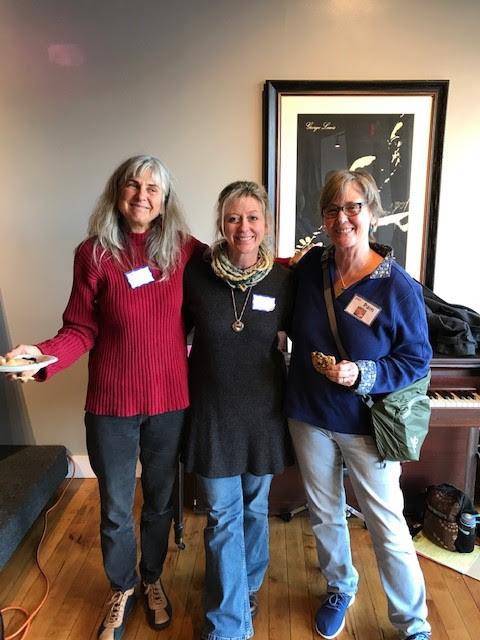
Cynthia Fisher, Nikki Sullivan and Pam Stratton
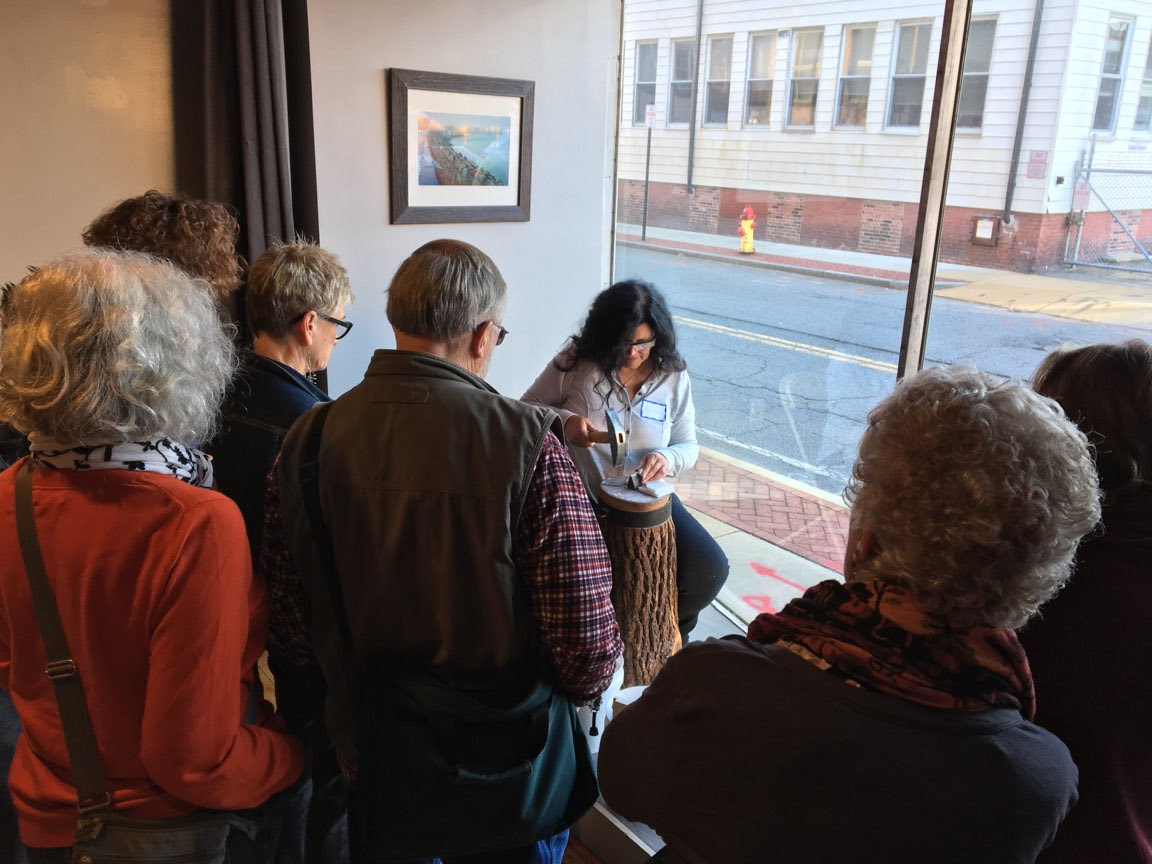
Anabella Wewer demonstrating Hammer and Hardie

Amy Marks and Carrie Fradkin
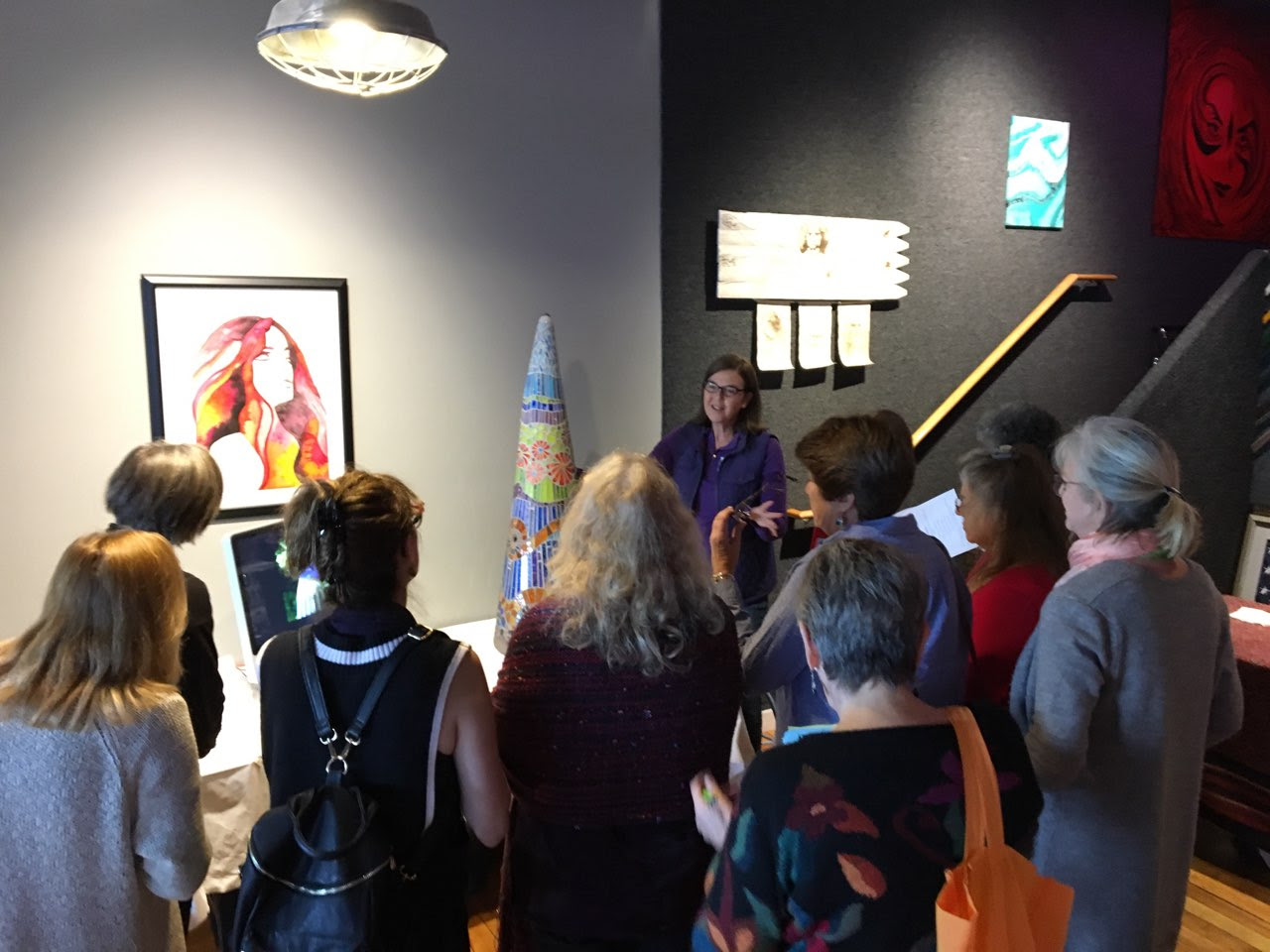
Laurie Frazier, “How I Made it”

Amy Marks and Michael Ferreira drawing the winner of the Raffle

Ouiji Morris and Jess Regalson
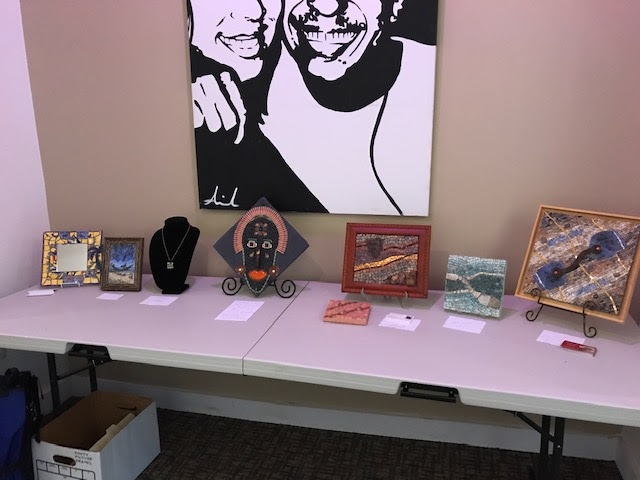

Karin Vander Schaaf, Terry Bromfield, Beth Goulet, Michael Ferriera
by amy lou marks | Oct 2, 2018 | events |
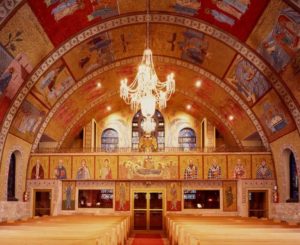
For nearly 50 years, artist Robert J. Andrews has devoted his life to creating mosaic icons in the Byzantine style for churches across the US and UK. We visited one of his beautiful masterworks, the Transfiguration of the Saviour Greek Orthodox Church in Lowell. This church, which is affectionately called the “miniature San Marco’s of Venice”, is bedecked from floor to ceiling with mosaic icons from the hand of Andrews.
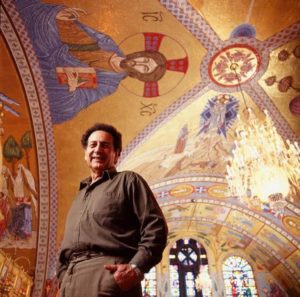
Over 20 NEMS members and guests learned about the mosaic icons by tour guide, Father Tom. The mosaics were paid for and commissioned by church members. The mosaic work at Transfiguration began in 1963 with the Platytera, mounted in the apse behind the altar and continued for 50 years until 2004. The composition of the icons is dictated by the church tradition, but the patrons of the Transfiguration Greek Church requested a predominance of female saints be included in the icons.
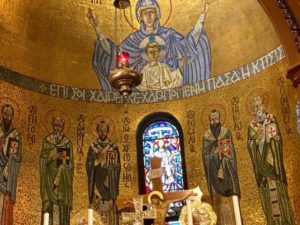
Father Tom described the process of creating a mosaic icon. First, Andrews prepared a “cartoon”, a drawing on paper of the proposed design. These hand-painted drawings were then sent to Citta d’Arte, a school and studio in Tuscany, Italy, where artisans hand-cut glass tesserae based on Andrews’ color drawings. In order to adhere to his artistry, they selected from over 5,000 different colors of glass. The glass tesserae were carefully set in and glued to the reverse side of his line drawings. When completed, the icon was carefully divided into units for shipping. Hauled to the west coast of Italy by truck, they were sent by ship, and sometimes by air, to United States.
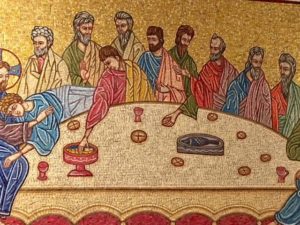 Andrews opened the crates and lay them out on the floor of the church. He inspected the work for any changes or corrections in reverse, since the mosaic laid face down on the paper backing. Only after the process of spreading the mortar on the wall and using special tools to beat and butter the icon into position, did he finally peel off the paper and see the result of his vision.
Andrews opened the crates and lay them out on the floor of the church. He inspected the work for any changes or corrections in reverse, since the mosaic laid face down on the paper backing. Only after the process of spreading the mortar on the wall and using special tools to beat and butter the icon into position, did he finally peel off the paper and see the result of his vision.
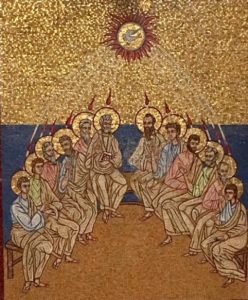
There was an engaged Q&A session and time to explore the mosaics. It was awesome!
Video featuring Robert J. Andrews: https://vimeo.com/1164833
More on Robert J. Andrews: http://www.helleniccomserve.com/robertandrews.html
by Cathleen Newsham | Aug 29, 2018 | events |
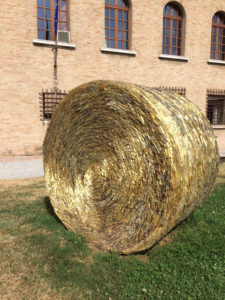
In the summer of 1973, I made my first visit to Ravenna, Italy. I had gone there to see the Byzantine mosaics that I had studied earlier that year in a history class. It was a short visit, culminating in a Beethoven organ concert at night in the Basilica of San Vitale. The mosaics of Ravenna were stunning to see in person. And then I left.
Many years later, after retiring from work, I began to take mosaic classes in Arlington, MA. It began with a two and a half hour ‘taster’ class and proceeded to more mosaic ‘experiments’ and more classes.
When planning a vacation in 2017, I was looking to do something different than only being a tourist. Someone suggested taking a mosaic class in Italy. I had not thought about Ravenna for years. In July 2017, I returned to Ravenna to take a five day mosaic class at The Mosaic Art School. The class was wonderful with students from various countries. While I did not create a ‘masterpiece’, I could see my progression from day to day.
In total, I was in Ravenna for six days. And six days was not enough.
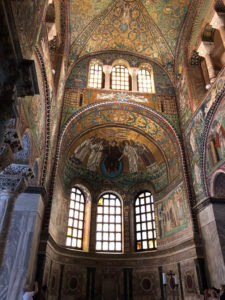
In June of this year, I returned to Ravenna to take another mosaic class. But this time, I planned to spend more time in Ravenna and also to visit some cities close to Ravenna that are easily accessible by train.
Ravenna is in the Emilia Romagna region in northern Italy. It is a UNESCO World Heritage site because of its 5th and 6th century mosaics. Ravenna was the capital of the Western Roman Empire from 402AD to 476AD. Its ancient history is rich with some interesting more recent historical events (supposedly the mosaic stars in the Mausoleum of Galla Plaida were the inspiration for Cole Porter’s song Night and Day).
Ravenna is basically synonymous with the word ‘mosaic’. Mosaics are present everywhere; not just in churches or museums, but on street corner signs, on benches, in parks, on sidewalks, on modern buildings, and of course in the mosaic studios and schools throughout the city. But Ravenna is also a food lovers’ paradise.
The Emilia Romagna region is home to other wonderful cities known for their regional foods. Parma is famous for its hams and cheese. Modena for its balsamic vinegars. Bologna for its fresh egg pasta dishes. And all of these can be had in Ravenna. Seafood is also in abundance in Ravenna. Marina dal Ravenna on the Adriatic Sea is a short bus ride away and is worth a visit for lunch or dinner.
Beginning around 6pm every day, prior to dinner most cafes offer ‘aperitivo’. Aperitivo is actually the pairing of a drink (alcoholic or not) with an assortment of finger food. It is a time to relax, read, spend time with friends or just people watch. The amount of food offered ranges from satisfying to an overabundance making it unnecessary (or impossible) to eat dinner. Dinner time is at 9pm. Breakfast is at 8am. Lunch is at 1pm. Aperitivo is at 6pm. It is a lot of eating.
Ravenna is a small city. It is a ‘walking’ (or biking) city. In the center of the city there is a pedestrian zone with many cafes and shops. At the center of the zone is the Piazza Del Popolo. From early morning to late at night it is busy with locals and some tourists. At night the area is filled with families eating dinner or walking around having gelato. The pace is slow and meandering seems to be a favorite past time. Compared to other famous destinations in Italy (Venice for instance), Ravenna is relaxed; uncrowded and, the local people are very friendly and inviting. Even those who do not speak any English will have a long conversation with you in Italian even when you have tried to make it clear that you do not speak much Italian. And Ravenna is a safe place. Possibly the most dangerous thing is the number and swiftness of the bike riders.
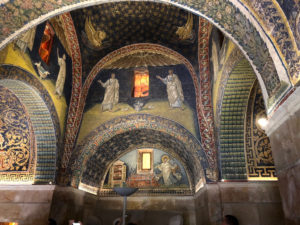
Ravenna is also home to Dante Alighieri’s tomb; live theater; an annual music festival; ballet, and other cultural events. But for me, it is about the mosaics. Aside from the Byzantine mosaics, contemporary mosaics abound in Ravenna. The Museo d’Arte della cittia di Ravenna (MAR) houses contemporary mosaics as well as paintings and sculptures. The museum is also home to the International Mosaic Documentation Center whose mission is research, study and the promotion of mosaic art.
This year I returned to the Mosaic Art School to take the five day ‘Standard Intensive’ class during which I made a Byzantine reproduction using the ‘double reverse’ technique and another reproduction using a contemporary technique. While the ‘double reverse’ technique was fascinating and fun (working on lime drawing out the tesserae, using a multitude of Italian smalti and some marble, gluing, washing, flipping from the temporary lime base to cement, etc.), the skills I acquired during the five days will be extremely useful as I move forward with future mosaics. I gained a much better appreciation of where to begin with the subject, how to create flow and possibly most importantly, just about mastering cutting using a hammer and hardie.
I have made a few friends (all ‘locals’) in Ravenna whom I hope to stay in touch with. And although it is a long time off, I think I will be returning to Ravenna again next year to make a floor mosaic!
by Beth Goulet | Aug 29, 2018 | events |
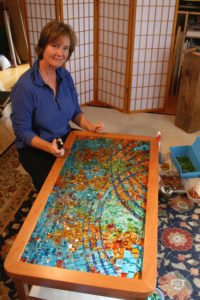
- How did you get started in mosaic art? About 11 years ago, my partner and I made a 25’x25’ brick patio of intersecting concentric circles that was inspired by all the beautiful piazzas in Italy. The center of each circle was a 8 inch circle that we needed to do something with. We placed pieces of brick and stone in the cement filled Sonotube slices to make small mosaics of our favorite things and places. That got me going. I then found a class that met once a week at Mass Art in Boston and made my first mosaic. But what really got me excited about mosaic art was Lynn Moore at Mosaic Smalti. After her class I made my Sunflower mosaic. I met Bill Buckingham and Michael Welch at a Cambridge mosaic show and tell where I brought my sunflower mosaic, that was also inspired by that same trip to Italy. Bill loved it and It became the cover for the catalog of the first Somerville Mosaic Exhibition. The rest is history.
2. What or who inspires you?
Wanting to create art for outside was my original inspiration. I am coming back to that now. I love the Spilimbergo Style. Currently I am enthralled with Dino Maccini’s work.
3. What is your favorite material and why?
I am a texture person. I like smalti and stone. I find the natural hues of stone and the bling of smalti pair really well. As a kid, I had a rock collection and always found geology interesting. I love fossils.
4. Where would you like to see your art go over the next few years?
I have started playing with encaustic wax and cold wax and oil paint in my mosaic work. I aspire to create abstract art integrating these materials and techniques.
5. Share a tip, either mosaic or life?
Let yourself play! My best work seems to come from letting myself be free and experimenting.
6. Why do you mosaic?
Mosaic was what made sense for outdoor art. I enjoy a beautiful yard and the hands on physical making of the art. I find the process meditative.
7. What is the best workshop you have taken and why?
Meeting Dagmar Friedrich in Spilimbergo Italy and learning the lime plaster technique. I really like open quiet space in a mosaic, the old world feeling it can give or the totally modern effect it can also create.
8. What are you working on now?
I am working with some hand made bark paper and encaustic wax with stone. I also have the challenge of integrating mosaic into a tree I am having carved into a sculpture in my yard.
by amy lou marks | Jun 19, 2018 | events |
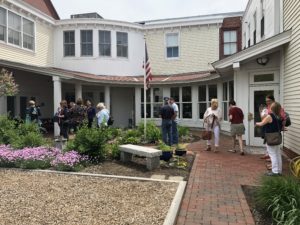
In January NEMS launched its first community project. Over 30 members made mosaic leaves from templates provided by Amanda Edwards. Amanda and crew installed these mosaics on a mural at the Ronald McDonald House in Portland, ME.
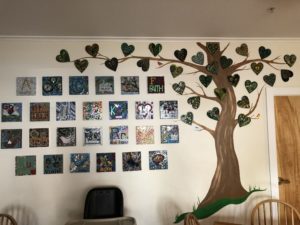
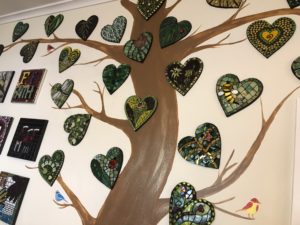


We visited the installation in early June as part of a Portland, ME mosaic tour. The tour started at Amanda’s Studio in Cape Elizabeth, Maine with light refreshments and a meet and greet. From there, participants visited the Ronald McDonald House (RMH) where they went on a special tour of the facilities and viewed the tree mural with heart-shaped leaves created by NEMS members. The mosaics in the mural were awesome, as you can see from the great pictures taken by Su Bailey.
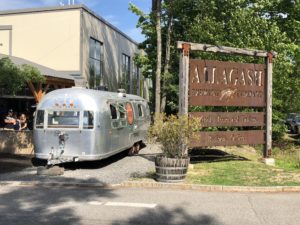
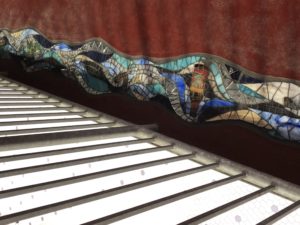
But that’s not all. From RMH, everyone headed to downtown Portland for lunch and a walking tour of Portland’s Old Port and Art’s District lead by Amanda. The program ended at Allagash Beer, where Amanda installed a 92′ floor mosaic along the mezzanine overlooking their bottling facility. Everyone had a great time touring the facility and, of course, tasting the beer.
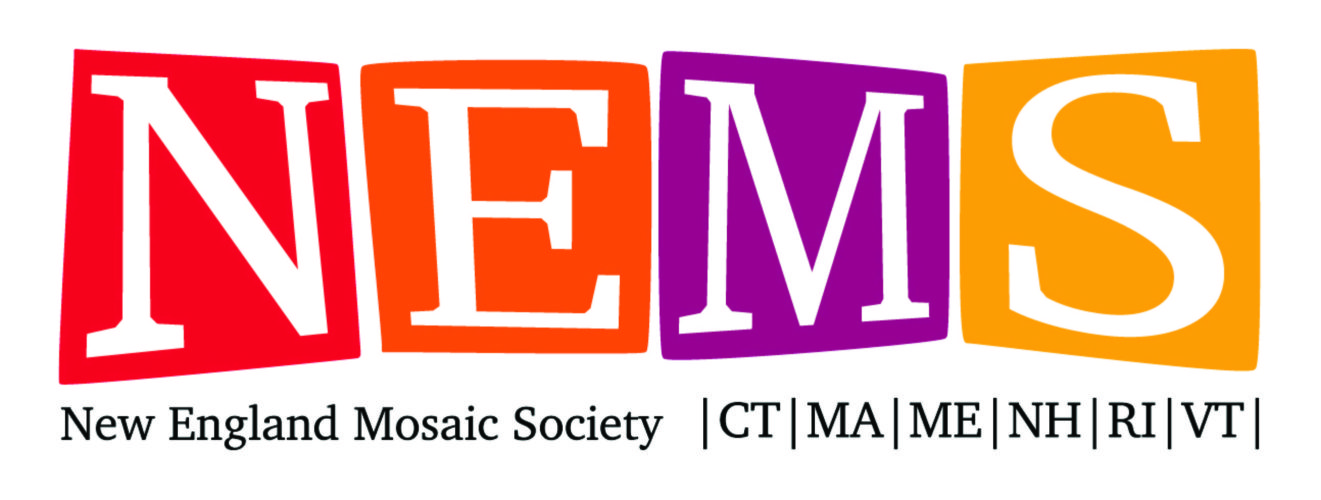












 Andrews opened the crates and lay them out on the floor of the church. He inspected the work for any changes or corrections in reverse, since the mosaic laid face down on the paper backing. Only after the process of spreading the mortar on the wall and using special tools to beat and butter the icon into position, did he finally peel off the paper and see the result of his vision.
Andrews opened the crates and lay them out on the floor of the church. He inspected the work for any changes or corrections in reverse, since the mosaic laid face down on the paper backing. Only after the process of spreading the mortar on the wall and using special tools to beat and butter the icon into position, did he finally peel off the paper and see the result of his vision.








